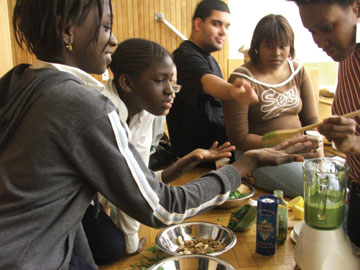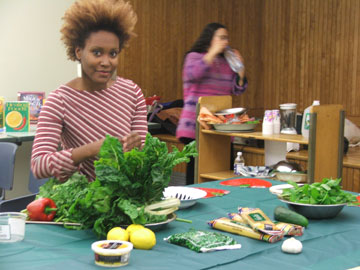March
2006
Teaching
Greens
By Elizabeth Johnson
|
|
Elizabeth Johnson.
Photo by Ben Witte |
 |
Learning to make pesto. Photo by Ben Witte |
There is a dangerous myth
circling around town about young people and vegetables. Word on the
street is young folks won’t be caught
dead consuming fruits and vegetables. Many of us have heard that crunchy
green things like broccoli, string beans and lettuce will be met with
staunch defiance and closed mouths by teenagers the world over. But
these ideas are far from the truth.
I’ve been teaching people, especially young people, to eat well for several
years. People who come to observe my classes are often amazed when they see kindergarteners
or teenagers sampling and enjoying fresh, seasonal salads, vegetable soups and
odd-looking raw veggies and fruits. Everyone wants to know, “What’s
your secret?” I’ve found there are a few things adults can do to
encourage young people to make better food choices.
Youth, like us adults, have likes and dislikes, and we must honor and respect
their tastes. The best way to show appreciation for their responses to the foods
they eat is to give them a working vocabulary that they can use to clearly express
their sentiments. For example, when I teach, my students are not allowed to say “ewww” or “that’s
nasty,” or “that’s good.” I teach my students to ascribe
adjectives to these thoughts. I encourage them to say “I don’t like
this because it is too bitter and the texture is too chewy,” or “I
like the combination of sweet and salty in this dish even though it’s not
presented well.” Then I ask the students to tell me how they would change
a dish so that they would like it. These types of exercises help empower children
to trust their taste buds and to think critically about food. They also let young
people know they don’t have to like everything they eat, but they do have
to at least try it and give it some thought.
Once we’ve got the young folks developing their palates and thinking discerningly,
we must involve them in the preparation of food. As with any subject, active
participation is key. When people invest time and energy into a project they
become more interested in the result even if the individual tasks do not intrigue
them. In other words, even if a student has no desire to eat chickpeas, working
with them to make a chickpea hummus may lead them to want to taste the fruit
of their labor. This step is an important one. The process of touching, tasting,
smelling, cutting and cooking raw ingredients and turning them into an amazing
dish is magical. It connects us to our food in a way that nothing else can. This
connection is one we want to savor; we want it to become a part of us. And even
if we don’t love the dish that we’ve made we want to at least like
it because we’ve touched it, we’ve had a hand in its creation.
At this point, our youth have learned how to taste and describe food, and they
know how to cook it. The next question is how do we get young people to buy into
cooking health supportive food for the long-term? The answer to this has a few
parts. The first is helping young people make the connection between what we
eat and our level of mental, physical and spiritual health. For me it seems like
a simple equation: Quality of food you eat equals quality of life you have. And
yet for some reason, while many of us fail to grasp this concept as it relates
to our bodies, we understand it quite well when it comes to our cars. For example,
most of us wouldn’t put poor quality gas or oil into our fancy cars. We
would not ride around town with dust all over our cherry red paint job. But,
when our friend shows up with a bag of mini-hamburgers, a side of fries, onion
rings and some pie, we thank them and are more than happy to fill up our tanks
with low quality fuel.
We must begin to recognize that food is for us what gasoline is for our cars.
It is the fuel that gives us the energy to complete each and every task we set
out to do each day. More importantly than gasoline though, food also affects
how we feel physically and emotionally and can prevent, cure or help treat illness.
Choosing good-quality, fresh foods will enable us, and the young people we encourage,
to function optimally.
All this may be hard for you to believe, I know, but it’s true. And interestingly
enough, one of the major challenges to getting young people to eat well is our
disbelief. How can we expect our children to eat well if we don’t believe
that they will? The negative expectations of adults create an atmosphere that
does not encourage healthy eating habits. As elders we must approach our youth
with openness and the assumption that they will and in fact want to eat well.
We must behave with the understanding that eating delicious, healthy foods is
natural and expected. This is the first and one of the most important steps to
getting young folks to begin to choose foods that will bring them health and
vitality.
I know this to be true because the young people I work with come to my classes
because they want to. Most of them do not receive school credit and do not get
paid. The young folks come initially, some say, for the free food and to be like
Emeril. But they stay because they feel nurtured and they learn valuable, applicable
skills and information that help them live better lives.
Elizabeth Johnson is the program coordinator for Community Food Education at
Just Food and teaches workshops to youth and adults through her own company Conscious
Cravers. She attended the Natural Gourmet Cooking School for Food and Health.
There are several New York based organizations that work with young people to
help them understand how to eat well and why it matters, including B-HEALTHY!
(www.b-healthy.org), Just Food (www.justfood.org) and Added Value (www.addedvalue.org).
For more information about interactive, hands-on workshops that encourage youth
and adults to engage in health supportive eating habits, contact Elizabeth Johnson
at ebeth2301@yahoo.com.
|
|
|
|
© STEALTH TECHNOLOGIES INC.
|
|


